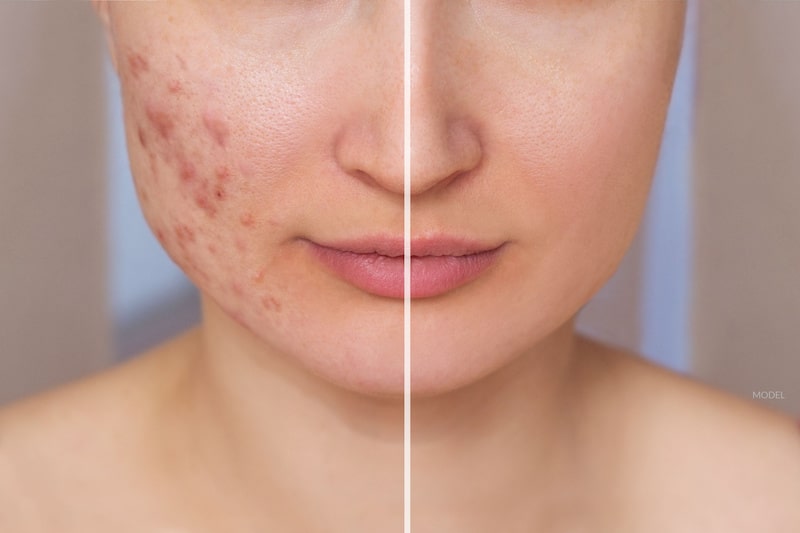Recognizing the Numerous Skin Disease and Reliable Therapy Alternatives for Acne Marks
Acne marks stand for an intricate interaction of skin problems that substantially influence people' self-esteem and overall skin health. Comprehending the distinct types of acne marks-- hypertrophic and atrophic-- along with their underlying causes, is pivotal for identifying effective treatment strategies. Different healing choices exist, varying from sophisticated dermatological treatments to natural treatments. The effectiveness of these treatments often pivots on individualized evaluations by certified experts. As we check out the landscape of acne scar monitoring, it ends up being evident that the trip toward more clear skin may involve greater than just topical remedies.
Sorts Of Acne Scars
The 2 primary classifications of acne marks are atrophic and hypertrophic scars. These scars are more identified into three subtypes: ice pick marks, which are slim and deep; boxcar scars, which are larger and have distinct sides; and rolling marks, which create a wave-like appearance due to unequal skin structure.
On the other hand, hypertrophic scars result from an overproduction of collagen during the recovery procedure, bring about raised areas on the skin. These scars are commonly strong and can differ in color, in some cases appearing red or darker than the surrounding skin.

Sources Of Acne Scarring
Marking takes place as a result of the body's natural recovery reaction to inflammation and injury brought on by acne lesions. When acne forms, it causes an inflammatory action, resulting in the launch of different cytokines and growth variables that promote recovery. This procedure can in some cases lead to too much tissue development or insufficient fixing, resulting in scars.
The key root causes of acne scarring consist of the seriousness of the acne itself, period of the sores, and specific skin types. Extreme inflammatory acne, such as nodules and cysts, is more most likely to cause scarring because of much deeper tissue damage. In addition, improper handling of acne sores, such as pressing or selecting, can intensify cells injury and swelling, enhancing the chance of scarring.
Genetic tendency additionally plays a significant function; people with a family members background of scarring go to a greater risk. Additionally, skin type and shade can affect scar formation, as darker skin tones might experience post-inflammatory hyperpigmentation, while lighter skin might develop atrophic scars.

Treatment Choices for Scarring
Effective treatment options for acne scarring vary depending on the kind and extent of the marks. Usually classified right into atrophic, hypertrophic, and keloid scars, these conditions require customized strategies for optimum outcomes.
For atrophic scars, which are characterized by a loss of tissue, therapies such as chemical peels, microdermabrasion, and laser treatment are frequently utilized. These methods promote skin revival and boost collagen manufacturing, thus improving skin texture. Subcision, a minimally intrusive procedure, can also be effective by separating coarse bands below the skin.
Hypertrophic and keloid marks can be a lot more challenging to treat. Alternatives consist of corticosteroid injections to lower swelling and flatten the marks. acne and acne scars treatment. In some cases, cryotherapy or laser therapy may be recommended to decrease their look
Surgical options are available for extreme scarring, where excision or skin grafting might be necessary. It's essential for people to browse around here seek advice from a skin doctor to evaluate their details scar kind and go over one of the most appropriate treatment strategy. Combining several therapies commonly yields the very best outcomes, making certain that each client's one-of-a-kind skin disease is resolved efficiently.
Natural Home Remedy and Natural Solutions
All-natural remedies and natural remedy can give an obtainable technique for people seeking to enhance the appearance of acne scars. Numerous active ingredients found recommended you read in the home cooking area have actually demonstrated prospective advantages in boosting skin texture and promoting recovery.
One popular remedy is aloe vera, understood for its anti-inflammatory and soothing properties. Applying fresh aloe vera gel directly onto the scars can assist boost skin hydration and reduce redness. Honey possesses natural antibacterial and moisturizing high qualities that can help in mark recovery. It can be made use of as a mask, left useful reference on for 30 mins prior to washing off.
Another reliable option is lemon juice, which serves as a natural exfoliant and can lighten hyperpigmentation. However, it ought to be used very carefully, as it may cause photosensitivity. Oat meal masks are likewise useful; their gentle exfoliation can aid get rid of dead skin cells while calming inflammation.
Vital oils, such as tea tree oil and lavender oil, can additionally support mark recovery as a result of their antimicrobial homes. It is essential to perform a spot examination before using any type of treatment to ensure there are no damaging responses. These natural remedies can be a corresponding method in the trip to reduce acne scars.
Protecting Against Future Scarring
Taking on a positive approach to skincare can substantially decrease the threat of establishing future acne scars. Among the essential approaches is to handle acne effectively as it develops (acne scars). This includes using non-comedogenic skin care products and medicines suggested by skin specialists that target acne without aggravating the skin. Routine cleaning, exfoliation, and hydration can help keep skin health and stop clogged pores.
Furthermore, staying clear of the temptation to press or pick acne lesions is vital, as this can lead to inflammation and subsequent scarring. Rather, people should concentrate on applying topical therapies that advertise recovery and reduce inflammation. Components such as salicylic acid, benzoyl peroxide, and retinoids are understood for their efficiency in taking care of acne and reducing scars.

Last but not least, maintaining a healthy diet plan abundant in anti-oxidants and remaining hydrated supports skin regeneration. By carrying out these preventative measures, people can substantially lower their danger of future scarring and promote general skin wellness.
Final Thought
In final thought, an extensive understanding of acne scars, incorporating both hypertrophic and atrophic types, is important for effective therapy methods. Assessment with a dermatologist continues to be imperative to design individualized approaches that take into consideration private skin types and mark seriousness, inevitably improving the efficacy of mark management strategies.
Acne scars stand for a complicated interaction of skin conditions that significantly effect individuals' self-confidence and overall skin health and wellness. The two main categories of acne scars are hypertrophic and atrophic scars. These marks are further identified into 3 subtypes: ice choice scars, which are narrow and deep; boxcar marks, which are wider and have distinct edges; and rolling marks, which create a wave-like look due to irregular skin texture.
A detailed assessment with a skin doctor can help figure out the most appropriate intervention, taking right into account the person's skin type, scar extent, and overall skin health and wellness.
Appointment with a dermatologist stays imperative to develop individualized approaches that consider private skin kinds and mark extent, ultimately improving the effectiveness of mark monitoring techniques.